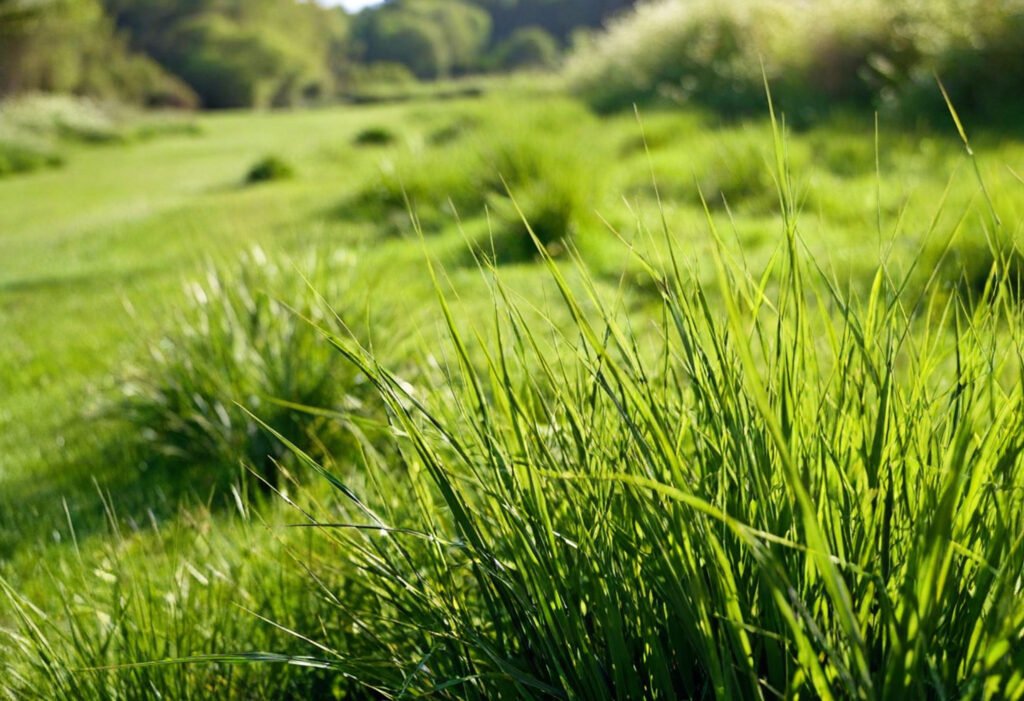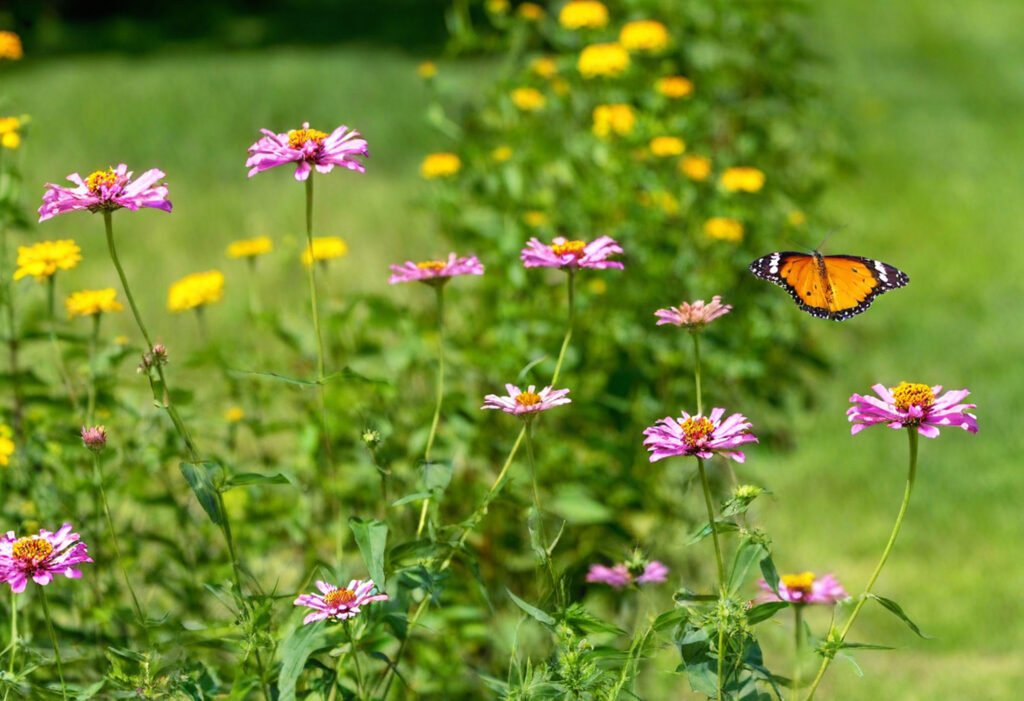Sustainable grass options remain overlooked, even though America’s landscape irrigation consumes one-third of residential water, over 7 billion gallons daily. My research found that turf blankets about 49,421 square miles of American land, which is three times more than irrigated corn. This made me realize our lawn choices environmental effects.
Traditional lawns act as artificial monocultures that need too many fertilizers, herbicides, pesticides, and water. The switch to a sustainable lawn can reduce our ecological footprint drastically. Native plants and eco-friendly grass alternatives need nowhere near as much water and maintenance while they support local biodiversity. These sustainable options help restore local ecosystems, improve soil quality, and boost resilience against environmental stresses.
This piece offers practical ways to reshape your yard into an environmentally beneficial space. Your local ecosystem will thank you, and you won’t have to give up beauty or functionality.
Understanding the Role of Grass in Local Ecosystems

“A well-maintained lawn provides ecological benefits like erosion prevention, improved air quality, and biodiversity support.” — Dr. John Roberts, Environmental Scientist, Lawn and Reticulation Australia
Grass does more than just look good—it shapes and supports local ecosystems by working with soil, wildlife, and water. Learning about these connections helps us make better choices about eco-friendly lawn care.
How grass supports soil health
Grass changes soil structure through its vast root systems. Unlike regular turf, sustainable grass varieties grow deeper roots that boost soil organic matter by a lot. These root networks create paths for helpful microorganisms that improve nutrient cycling and make soil more fertile.
Studies show that perennial grasses add lots of organic matter to soil when their plant material breaks down, making it rich with key nutrients. These plants’ fibrous roots protect against soil erosion. They make soil more breathable, help water soak in better, and keep soil structure stable. The way perennial grasses grow and decay also keeps releasing nutrients steadily, which maintains soil fertility.
Native grasses are great at building healthy soil. Their deep roots reach way down into the ground and pull up nutrients from lower soil layers. This natural process boosts soil carbon storage, with grasslands storing up to 34% of the world’s terrestrial carbon.
The connection between grass and pollinators
Grass helps pollinators in ways you might not expect. More than 70 types of butterflies and moths need native grasses to complete their life cycles. These grasses give them a place to grow as larvae and protect them from predators and bad weather.
Smart grassland management that encourages plant variety makes pollinator networks stronger and more stable. Well-managed grasslands create layers of habitat that give pollinators food, shelter, and nesting spots. Dead grass at the bottom of grass clumps makes perfect protection for eggs, caterpillars, and pupae during winter.
Scientists have found that fewer native grasslands mean fewer butterflies, bees, and moths. So, adding different native grasses to your eco-friendly lawn creates safe paths for pollinators to move through the landscape.
Effect on local water cycles
Grass plays a vital part in managing local water cycles. Sustainable grass alternatives have deep, thick roots that let rain soak deep into the ground, filling up groundwater supplies. Grasslands can soak up extra rain during storms, which controls water flow into streams and lowers flood risk.
Healthy grass-covered areas store about 88.7% of all rainfall in the soil instead of letting it run off. This stored water slowly feeds streams, springs, and lakes, which keeps the water cycle going. Grass also works as a natural filter by catching pollutants and extra nutrients as water flows through its roots.
Research proves that well-managed eco-friendly lawns create their water cycle. They pull water from the ground through evapotranspiration and release it into the air as moisture. Without this natural “water pump” working, we get less rainfall, streams dry up, and the land becomes drier.
Key Practices for a Sustainable Lawn
A healthy lawn starts with understanding the science of good turf care. My years of research and hands-on experience have shown that specific techniques can deliver amazing results while staying eco-friendly.
1. Improve soil with compost and organic matter
Your lawn needs healthy soil as its foundation. A complete soil test will show exactly what nutrients your lawn requires. The best approach is to spread a quarter-inch layer of tested compost across your lawn. This adds beneficial biology and organic matter. The process provides about 2 lbs of nitrogen per 1,000 square feet. New lawns or renovation projects need compost mixed into the top 4-6 inches of soil.
2. Mow high and leave clippings
The mower height should be between 3-3.5 inches. This helps grass develop deeper roots and keeps weeds away. The grass can make food through photosynthesis at this height without using up stored reserves. Your grass clippings should stay on the lawn since they provide up to a third of the needed nitrogen throughout the season. These clippings work as natural mulch that stops weeds from growing and keeps moisture in the soil.
3. Water deeply but infrequently
Drought-resistant lawns need deep but less frequent watering. Roots grow deeper as they search for water this way. Watering works best early in the morning before 10 a.m. to avoid evaporation. Studies show that lawns need about 1-2 inches of water weekly during the growing season. Research in western Oregon suggests that lighter, more frequent watering (¼ inch four times weekly) creates healthier lawns while using less water.
4. Use natural fertilizers wisely
Natural fertilizers made from seaweed, bone meal, or feather meal work best. These materials break down slowly through soil biology and release nutrients gradually without causing runoff problems. Your soil test results will guide fertilizer application, which usually means 2-4 lbs of nitrogen per 1,000 square feet each year.
5. Aerate and dethatch when needed
Your soil might be too compacted if a screwdriver won’t easily go in. Core aeration helps by removing small plugs of soil. This lets air, water, and nutrients reach deep into the ground. Remove thatch once it gets thicker than ¼ inch. Both these steps improve how water drains and help roots grow stronger.
Eco-Friendly Grass Alternatives That Work
Your yard can become an eco-friendly oasis with alternatives that go beyond traditional turf. These options help your local ecosystem and need less upkeep.
Clover lawns
Dutch white clover creates a thick carpet that fights weeds, stops erosion, and cuts down the need for herbicides and fertilizer. This adaptable legume fixes nitrogen from the air into the soil, which makes it self-fertilizing. The plant does well in zones 4-9 and adapts to both sun and partial shade. You’ll only need to mow it sometimes to clear brown flowers. Clover stays green all summer, handles drought well, and gives pollinators a friendly home at a good price.
Native grass blends
Native grasses like Texoka Buffalograss and Blue Grama make lawns that fit perfectly with local conditions. These local varieties grow deep roots that make the soil healthier and naturally prevent erosion. Your native grass blend will need less water, fewer chemicals, and less mowing compared to regular turf. Local wildlife and biodiversity thrive because these grasses create familiar spaces for native species.
Ground covers like creeping thyme
Creeping thyme spreads into a fine-leaved carpet with small pink, white, or purple flowers. People love its pleasant smell when they walk on it. This tough ground cover works best in zones 4-9 and likes full sun to partial shade. Sandy or rocky soil with good drainage makes it happy. Creeping thyme looks great along paths and in small lawn areas where foot traffic stays light, and it needs little care.
Low-mow fescues
Dwarf fescue varieties create tough turf that rarely needs cutting. Deep fibrous roots make these grasses durable, and they keep their rich green color in hot weather. These special fescues grow well in sun and shade, so they fit many yard conditions. Their naturally short growth means you won’t need the weekly mowing that regular grass demands.
Wildflower meadows
Meadow landscapes blend colorful flowers with native grasses to create living, breathing ecosystems. Helpful insects, birds, and small animals find food and shelter in these natural spaces. A good meadow design mixes quick-blooming annuals with lasting perennials. These meadows need no additional water, fertilizers, or pesticides once they take root. You’ll only need to mow once or twice a year to keep them healthy and looking good.
How Sustainable Grass Choices Help the Environment

“Through photosynthesis, turfgrass captures atmospheric carbon dioxide and converts it into organic matter within the soil, thus reducing greenhouse gasses and playing a vital role in mitigating climate change.” — NASA Earth Science Division, NASA, leading authority on earth and environmental sciences
Your eco-friendly grass choices create amazing environmental benefits that go way beyond your yard. These sustainable lawn practices make a real difference to our ecosystems.
Reducing chemical runoff into waterways
Chemical runoff from traditional lawns pollutes our water bodies. Rain carries fertilizers and pesticides straight into streams and lakes. This causes harmful algal blooms and contamination. Eco-friendly grass options need fewer chemicals, which reduces pollution by a lot. Using phosphorus-free fertilizers and organic lawn care stops 40-60% of nitrogen from contaminating water sources. The “Don’t ‘P’ on Your Lawn” campaign aims to reduce phosphorus that leads to eutrophication in waterways.
Lowering carbon emissions from lawn equipment
Gas-powered lawn equipment creates massive pollution—one hour of operation produces pollution equivalent to driving 300 miles. Eco-friendly grass alternatives need less mowing, which cuts carbon output directly. Research shows that cutting mowed areas by just one-third reduces carbon emissions by about 50,000 pounds each year. Electric and manual equipment produce zero direct emissions and create less noise.
Supporting biodiversity and native species
Wildlife runs on diverse lawns that create vibrant ecosystems. Unlike single-species lawns, eco-friendly grass alternatives:
- Provide essential homes for pollinators and helpful insects
- Create shelter for small mammals and birds
- Support soil microorganisms that improve nutrient cycling
- The foundations of wildlife corridors that help species move through landscapes
Clover lawns excel at attracting pollinators while naturally adding nitrogen to the soil.
Improving drought resilience in urban areas
Eco-friendly grass choices help curb water shortage issues. Traditional lawns use over 3 trillion gallons of water yearly nationwide, while drought-tolerant alternatives need minimal watering. Native perennial grasses grow deep roots that break up compacted soils. This creates spaces that soak up stormwater. Better water absorption reduces flooding and refills groundwater supplies. Healthy lawns can store about 88.7% of rainfall in the soil instead of losing it as runoff.
Conclusion
Eco-friendly grass choices mean nowhere than just making our yards look beautiful. Our research shows how traditional lawns consume resources while sustainable alternatives enhance local ecosystems. Native grass varieties, clover lawns, and other eco-friendly options reduce water consumption, minimize chemical usage, and support biodiversity naturally.
Scientific evidence proves our lawn choices’ impact on the environment. Grasses with deep roots enhance soil structure, store carbon, and strengthen local water cycles. Sustainable lawns also create vital habitats for declining pollinator populations. These benefits reach way beyond the reach and influence of individual properties and contribute to healthier watersheds and resilient communities.
The transition needs careful planning but offers remarkable rewards. Raising mower heights, reducing watering frequency, and adding organic matter will revolutionize your lawn’s health. These changes cut down maintenance needs while creating spaces that heal our environment.
Changing 50-year-old lawn practices might seem daunting initially, but the future benefits outweigh the effort. Sustainable grass options turn us into active participants in nature’s restoration. Our individual choices shape our environment together. A sustainable yard starts with one simple choice—picking grasses that align with nature’s ways.

![Why Your Sustainable Grass Could Save Local Ecosystems [Expert Guide]](https://mowingmagic.com/wp-content/uploads/2025/05/Why-Your-Sustainable-Grass-Could-Save-Local-Ecosystems-Expert-Guide-optimized.webp)